Like the Berlin Wall, the Cupar Way "Peace Wall" in Belfast has cut an urban landscape in half for decades. Unlike the Berlin Wall, it is regularly reviewed on Trip Advisor.
The wall, one of dozens that divide the capital of Northern Ireland, is listed as one of the city's top attractions. Bus and cab tours regularly stop by and encourage tourists to scrawl their own messages on it. It has stood for 45 years, 17 longer than the Berlin Wall.
"Conflict tourism" has become a big industry for Belfast in recent years, in the same way tourists in Berlin can visit Checkpoint Charlie or buy what peddlers insist is a piece of the wall. But in Northern Ireland, it reflects a disconnect between outsiders - be they politicians or tourists - and people living with very recent memories of the violence.
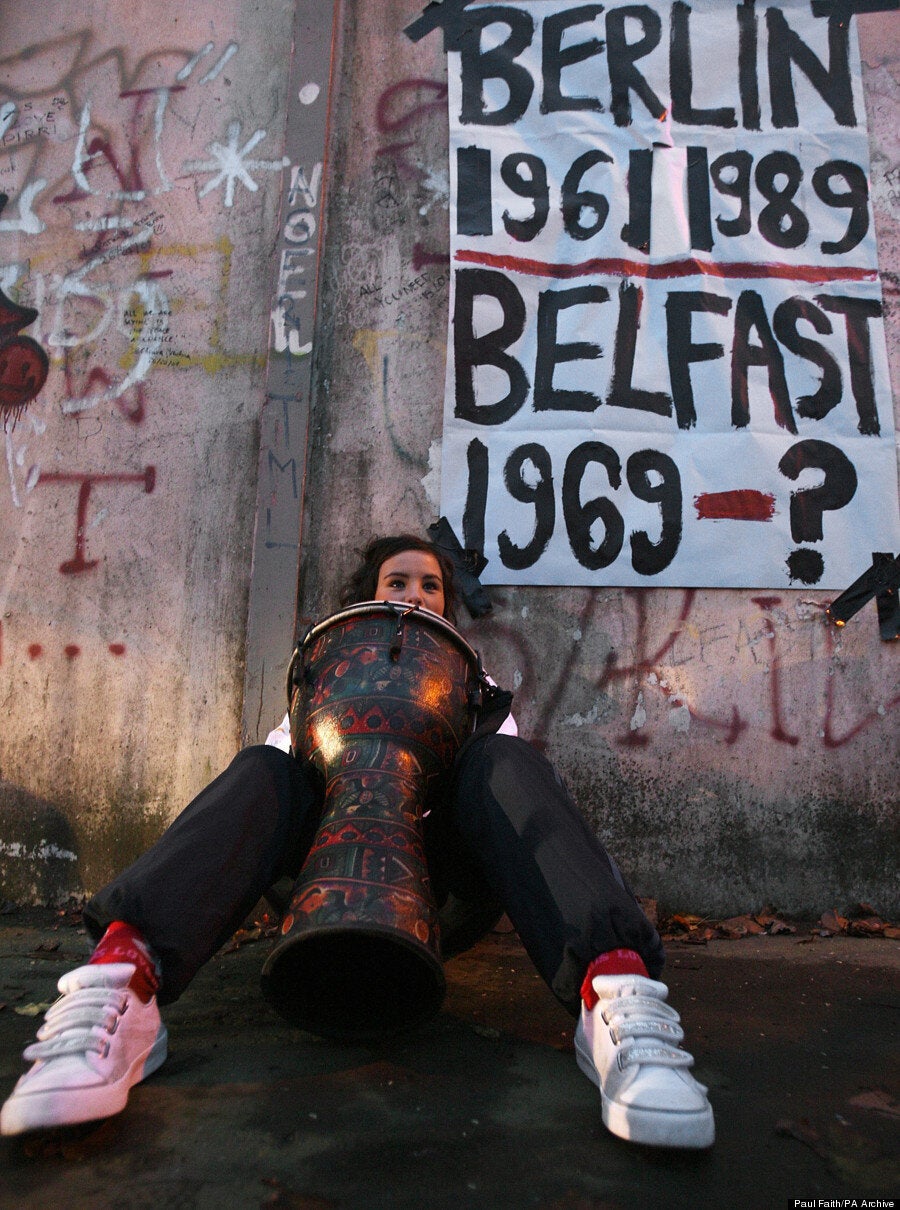
A mural on a peace wall, painted on the 20th anniversary of the fall of the Berlin Wall
The decades of bloodshed, officially and euphemistically dubbed "The Troubles" but sometimes simply just "The War", is over. The walls may look like monuments to the past to be graffitied and photographed, but for the people living in their shadows, sectarian strife between Protestant Unionists, who historically gravitated towards remaining part of the UK, and Catholic Nationalists, who gravitated towards joining the Irish Republic, is not a thing of the past. Peace and reconciliation are not the same thing. A 2012 study showed almost 70% living in "interface areas" near the walls feared for their safety without them.
Put simply, the walls prevent crossing between Protestant areas on one side and Catholic communities on the other. Some walls restrict access completely, while others use gates with limited opening hours to restrict movement. Segregation is less intense than it was around the time the first peace walls were built in 1969, when the British Army was sent in to Northern Ireland to keep the peace after rioting and began building temporary fences, but it persists.
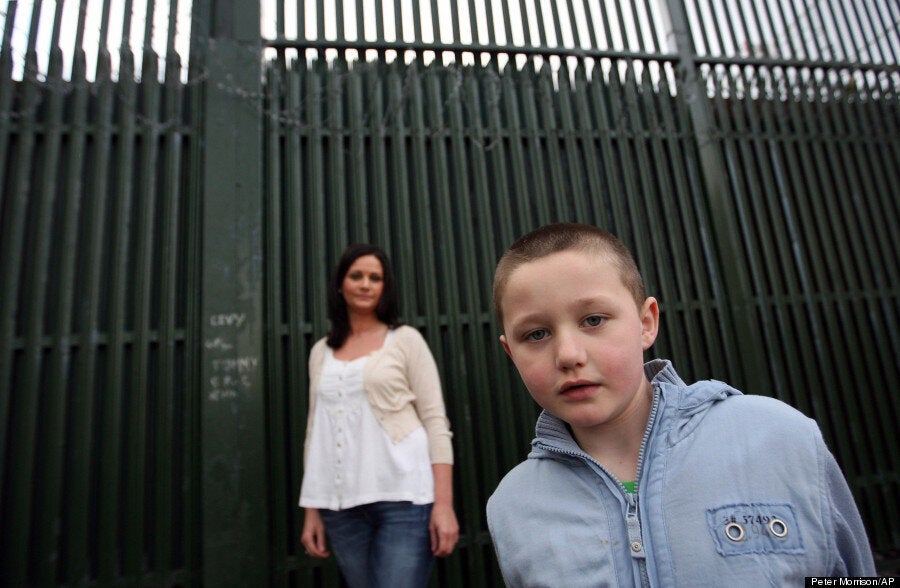
Alison Quinn with her seven-year-old son Cein in 2008
A total of 93% of Northern Ireland's children attend schools that are wholly or predominantly Catholic or Protestant. Speaking in 2008, 32-year-old Alison Quinn who lived in the lower Falls area of Belfast with her seven-year-old son Cein, was aggressively opposed to removing the peace wall her block of flats backed on to.
"No. No way does that peace line come down," she told The Associated Press at the time. "It's definitely not safe to take it down, and I don't think it ever will be. There's bitter loyalists over there. They're out drinking in the street at night. If you take it down, they'd have easy access here and come over starting fights. You'd just be asking for trouble."
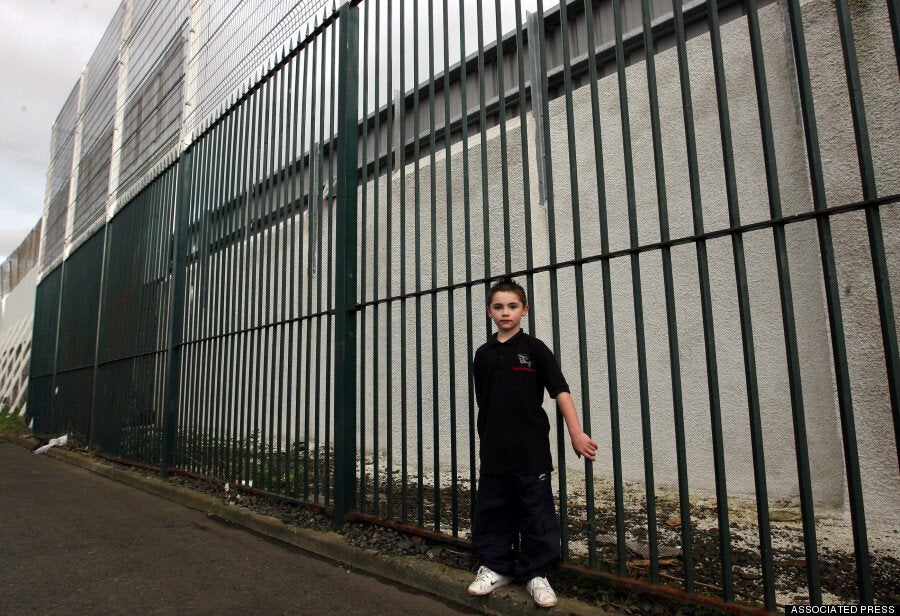
Lee Young, pictured in 2008 aged eight, lived just 200 yards from Cein on the other side of the wall but had never met him
Roisin McGlone grew up in the Catholic Falls Road area of Belfast in the shadow of the Cupar Way wall that went up in 1969. The structure stands up to eight metres high and is close to half a mile long. She remembers going shopping with her mother in the Protestant Shankill Road area as a child in the 1960s and being warned "don't mention the flags", referring to Union Jacks that hang everywhere to emphasise their allegiance. She did not heed the advice.
"I remember [my mother] tightening her grip on my hand and taking me home," she tells The Huffington Post UK. "Growing up, except for shopping outings, it was total segregation."
In 1998, the historic Good Friday Agreement saw nearly 30 years of violence end and the paramilitaries that fought the war and the counter-insurgency, disarmed. The agreement involved a fundamental reshaping of Northern Ireland - a power-sharing arrangement to allow the parties from both sides to be in government, prisoners held for crimes committed relating to The Troubles were released and the Protestant-dominated police force was reformed and re-branded.
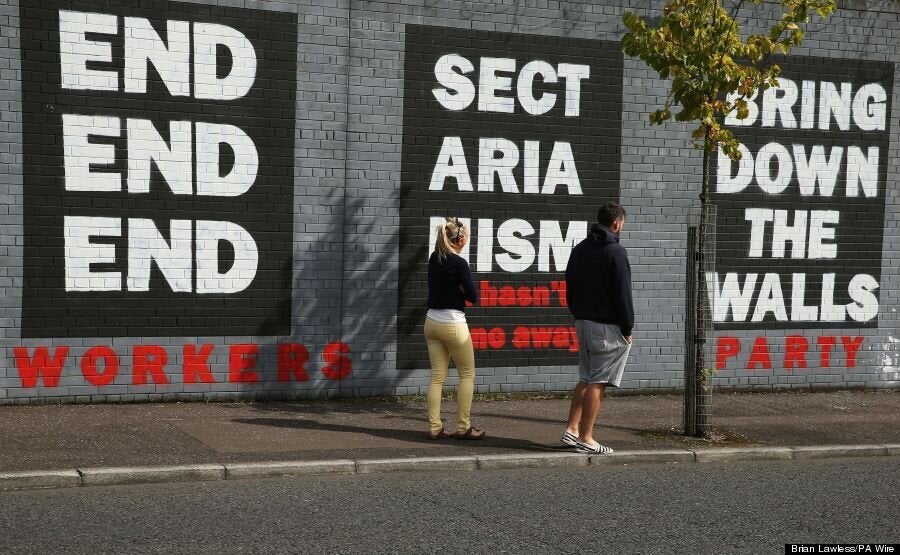
A mural painted on the peace wall on Northumberland Street, Belfast
At around the same time, Ms McGlone, now an experienced youth worker, became director of Inter-Action Belfast, a community group that works with people on both sides of the walls. She says the level of violence at the walls during The Troubles made scepticism over the sustainability of the peace deal understandable.
"People want to be safe, that's not to say they hate their neighbours," Ms McGlone says. "People don't feel secure enough to take them down. What if you lived there? What if you had grown up in The Troubles? Seen the murders? Ninety per cent of those killed in the troubles died within 100 metres of a peace wall. They're not reassured by people just saying 'let's take down your wall, it'll be grand. I live 20 miles away but, it'll be great'."
She stressed the need to "reassure" people near the walls to overcome their fears: "Once the wall comes down, that's it. You don't get a second chance."

One of the walls in 1969
The public rhetoric about the walls does not always acknowledge these concerns. Politicians from both sides of the Atlantic and the sectarian divide have talked up a narrative of peace and reconciliation in Northern Ireland. The peace walls, lingering symbols of suspicion and fear, are an obstacle to this. Last year, Prime Minister David Cameron told Parliament the peace walls should go: "What we need is politicians in Northern Ireland to build a shared future, to take down the peace walls... People have come a huge way and we need to continue that vital work."
Three months later, Barack Obama told a crowd in Belfast: "There are walls that still stand, there are still many miles to go." He adds: "You have to remind us of hope again and again and again. Despite resistance, despite setbacks, despite hardship, despite tragedy, you have to remind us of the future again and again and again."
Barely a 10-minute walk from where he spoke, stands a massive wall that separates the Protestant Cluan Place from the Catholic Short Strand area. He did not visit it.
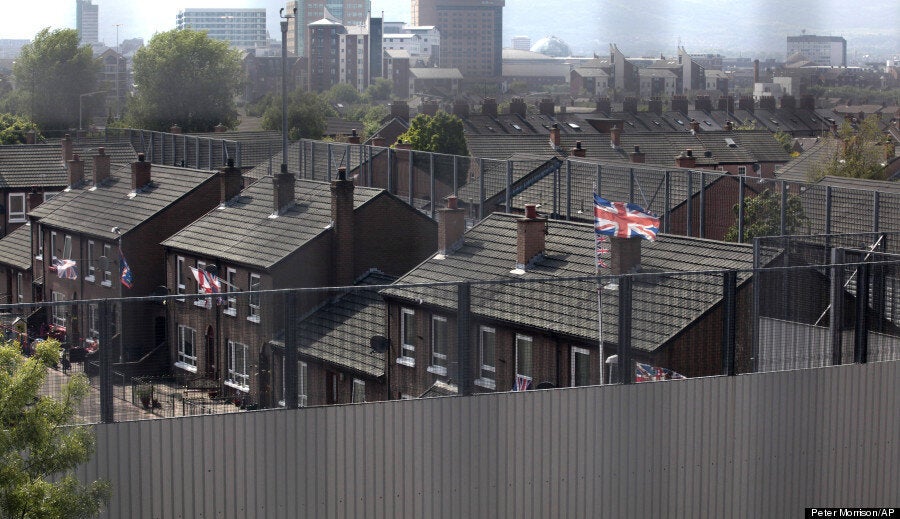
The British Union flag flies from the Protestant Cluan Place area of East Belfast
It is often reported the number of peace walls has increased in the last 20 years. But their actual number depends on the method of counting. Northern Ireland's Department of Justice administers 53, but a study counted 99 in Belfast, where the vast majority are. Dr Jonny Byrne, an expert on the walls, says they are not all like the larger, famous "Berlin Wall style," although the Cupar Way wall is similar in stature. Some structures are only small corrugated iron fences, he points out, and the fact that the number of them has gone up does not mean necessarily mean there is a larger amount of new structures across the city.
Cupar Way is one of eight walls that divide the Shankill and the Falls in Belfast. In total, the walls are estimated to be around 21 miles long. The Berlin Wall was 96 miles long.
Northern Ireland's government says it wants to bring down every wall by 2023. But the situation is too complicated for this to happen on any one person's orders, and the government says it will only act with "engagement, consent and support" of people living near them.
The Belfast Interface Project
The Belfast Interface Project, which works to develop "creative approaches towards the regeneration" of the city's interface areas, has produced an interactive map of Belfast showing all the peace walls in the city. The map shows the sheer range of fences - some are buffers and fences, some gates with vehicle access, some solid walls and others are walls with fences above them to increase their height.
Dr Byrne, a University of Ulster academic, co-wrote a 2012 report on people's attitudes to the walls. He has a phrase to describe how complicated the peace walls have become, one he says that can apply to all politics in Northern Ireland. "The abnormal is normal," he says.
His report revealed a contradiction between long-term hopes and short-term fears. A total of 69% living near a wall would fear for their safety came down, while 58% say they would worry about the police's ability to contain violence. But 58% also say they would like to see them come down "at some point in the future".
Different places have different fears, Dr Byrne says, but adds the themes people mentioned when discussing the removal of the walls as: "Community safety, fear of being attacked. But also fear of the unknown. People don't like to change. People are comfortable with what they know."
"[In] each community, the approach is so different. In some communities, the walls mark where some families who lost loved ones (during The Troubles). In others, there are concerns about anti-social behaviour and youth violence," he says. "When you get down to the micro-level, it (removing the walls) becomes very difficult. None of this was envisaged when the British military was putting them up."
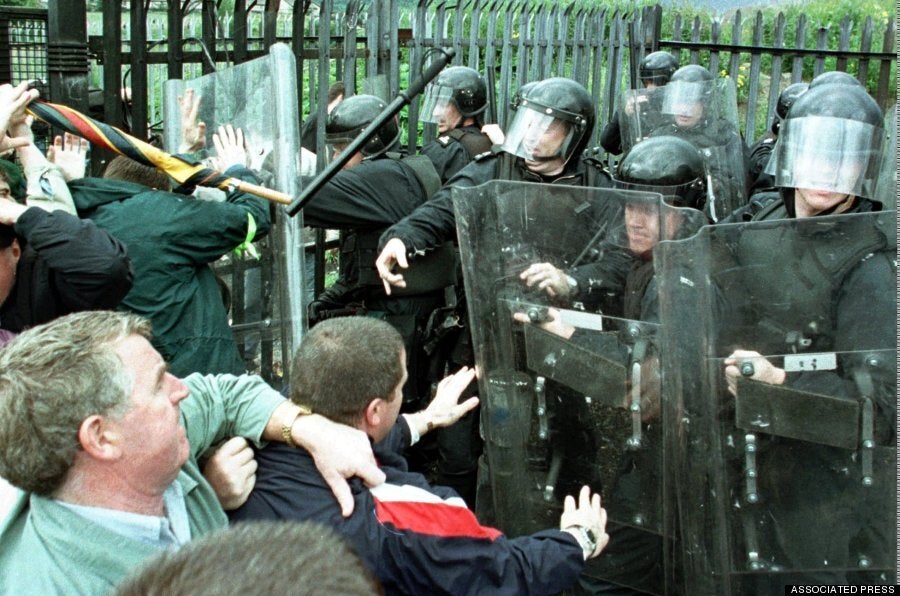
Catholic rioters clash with police in 1998, at a peace wall in West Belfast where a Protestant Orange Order parade was to take place
He adds the report showed a wide divergence in views on the walls between people living close to them and the rest of Northern Ireland, where 76% of the public think they should come down "now or in the near future". Dr Byrne says: "They look bad in terms of articulating a positive peace process. If you're pushing a narrative of peace of reconciliation, the walls don't fit that. But if you've spent your whole life living close to them, if you're not part of that global conversation, they are an every day part of your life."
He adds: "Some of the walls have been up since 1969. That's two, three or four generations that have lived with it. When they've been there that long, and someone comes along and says 'we're going to take down your wall', the most common reply is 'why?'"
Recent years have seen progress but also setbacks in the journey to convince people the barriers can go. Gates in the walls to allow easier access typically close overnight or on Sundays. In 2011, a gate at Belfast's Alexandra Park — Europe's only public park bisected by a wall, which was built in 1994 to stop the open space being used for sectarian clashes — opened for the first time, though only for a few hours a day. In the same year, a gate that divided access between the Shankill and Falls Road communities started opening on Sundays.
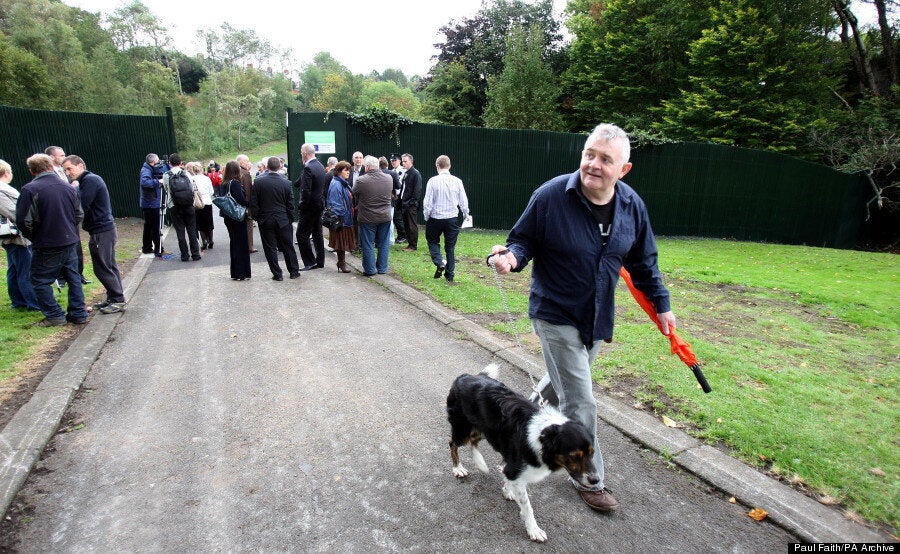
People walk through the open Alexandra Park gate for the first time in 2011
Last year, crowds of Protestants fought night after night with the police in violent demonstrations over the city council's decision to stop flying the British flag every day. Though the violence did not reach a wall, it prompted the Catholics of an area of East Belfast to seek more protection for St Matthew's Church. Stanchions were put up so temporary nets could be erected when tensions rise again.
But there has not been what Ms McGlone calls large-scale "inter-community violence" - the type the walls are designed to prevent - for more than a decade. The flag protests did not affect the opening times of any of the gates.
She insists things are getting better. Citing an example, she describes how Inter-Action runs a system of distributing phones to volunteers, who each have responsibility for a segment of a wall and alert others to potential trouble and try and defuse the situation.
"Things have improved dramatically. If you spoke to me 10 years ago I'd tell you I get a call (as part of the scheme) once a week," she says. "Now, I would get a call about every three months. That's the difference."
She says people living near the walls had not been responsible for violent disturbances there but says they could become targets because they are obvious "demarcation points".
She also says gates used to close, by mutual agreement, 10 minutes before the end of football matches between the Glasgow Rangers and Glasgow Celtic, teams whose Protestant and Catholic supporters have had a bitter, sectarian rivalry that reverberates in Northern Ireland.
So will the walls come down by 2023? "Never say never," Dr Byrne says, sounding pessimistic. Ms McGlone says she doubts it will happen. She laughs as she remembers doing a phone interview with the BBC World Service in 1994, to mark the fifth anniversary of the Berlin Wall coming down, when she was asked the same thing - when will Northern Ireland's walls follow?
Dr Byrne stressed that the peace walls are very different to Berlin, a wall that "was one wall that symbolised one thing". "People didn't see the fall of the Berlin Wall coming though," he concedes.
The latest annual Peace Monitoring Report, published in March, agrees that the walls coming down will not be a "dramatic symbolic event" like in Berlin. "If the peace walls in Northern Ireland come down it will be a gradual process," it says, adding it would be "at times almost unnoticeable to all" except the locals.
SEE ALSO: